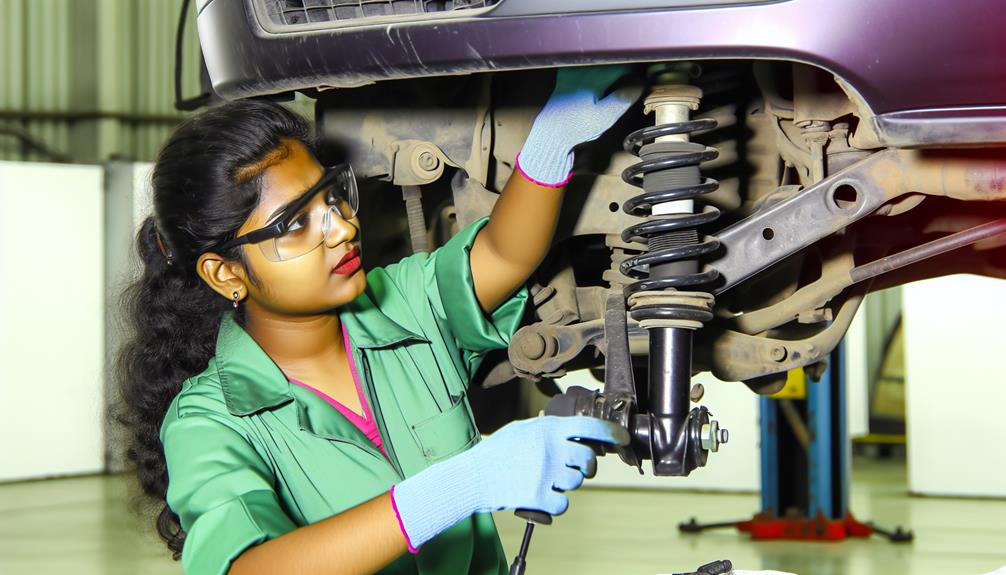To maximize your car's suspension lifespan, you need to take proactive steps.
Regular maintenance and inspections are crucial.
Ensuring proper tire inflation and alignment also play a significant role.
But that's not all. You must be mindful of harsh driving conditions and invest in high-quality suspension components.
And, of course, timely repairs and replacements are essential.
But what are the specific expert tips on achieving this? Stay tuned to find out how you can extend the life of your car's suspension system and ensure a smooth and comfortable ride for years to come.
Key Takeaways
- Regular maintenance and inspections are crucial for maximizing your car's suspension lifespan.
- Proper tire inflation and alignment help to distribute weight evenly and prevent premature wear on suspension components.
- Avoiding harsh driving conditions such as excessive acceleration, braking, and cornering can prolong the lifespan of your suspension system.
- Using high-quality suspension components and addressing repairs and replacements in a timely manner can enhance the performance and longevity of your car's suspension.
Regular Maintenance and Inspections
To maximize the lifespan of your car suspension, it's crucial to regularly perform maintenance and inspections. One important aspect of maintenance is ensuring proper wheel alignment. Wheel alignment refers to the adjustment of the angles of the wheels so that they're parallel to each other and perpendicular to the ground. Incorrect wheel alignment can lead to uneven tire wear, pulling to one side, and reduced handling performance. Regularly checking and adjusting the wheel alignment will help prevent premature wear and tear on your suspension components.
Another key maintenance task is inspecting and replacing suspension bushings as needed. Suspension bushings are rubber or polyurethane components that provide cushioning and flexibility to various suspension parts, such as control arms and sway bars. Over time, these bushings can deteriorate due to heat, age, and high mileage, leading to increased noise, vibration, and reduced suspension performance. Inspecting the condition of suspension bushings and replacing them when necessary will ensure optimal suspension function and longevity.
Proper Tire Inflation and Alignment
Proper tire inflation and alignment are essential for maintaining the longevity and performance of your car suspension. When it comes to tire inflation, it's crucial to maintain the recommended tire pressure specified by the manufacturer. Underinflated tires can lead to excessive wear on the suspension components, causing them to deteriorate faster. On the other hand, overinflated tires can result in a harsh and uncomfortable ride, as well as uneven tire wear, which can further compromise the suspension system's integrity.
In addition to tire pressure, wheel balance is another critical aspect of proper tire maintenance. Imbalanced wheels can cause vibrations, which can put unnecessary stress on the suspension system. This stress can lead to premature wear and tear, reducing the overall lifespan of your car suspension. Regular wheel balancing ensures that the weight distribution is even, minimizing the strain on suspension components and promoting a smoother ride.
To ensure optimal tire inflation and alignment, it's recommended to have your tires checked and adjusted regularly by a professional. They can use specialized equipment to measure tire pressure accurately and align the wheels to the manufacturer's specifications.
Avoidance of Harsh Driving Conditions

Avoiding harsh driving conditions is crucial for preserving the integrity and longevity of your car suspension system. By employing proper driving techniques and conducting a thorough road surface analysis, you can ensure that your suspension system remains in optimal condition.
When it comes to driving techniques, it's important to avoid excessive acceleration, braking, and cornering. Sudden and aggressive movements can put unnecessary strain on your suspension system, leading to premature wear and tear. Instead, practice smooth and gradual maneuvers, allowing your suspension to absorb the forces gradually and evenly.
Additionally, paying attention to the road surface is essential. Analyzing the condition of the road ahead can help you anticipate bumps, potholes, and other obstacles that could potentially damage your suspension. By adjusting your speed and taking alternate routes if necessary, you can minimize the impact on your suspension system.
Regularly inspecting your suspension components, such as shocks, struts, and springs, can also help identify any potential issues before they worsen. Look for signs of leakage, excessive rust, or any abnormal noises or vibrations that may indicate a problem.
Use of High-Quality Suspension Components
When considering the preservation of your car suspension system, one crucial aspect to prioritize is the utilization of high-quality suspension components. Upgrading to aftermarket suspension components can bring numerous benefits to your vehicle's performance and longevity. These components, manufactured by reputable brands, are designed with advanced technology and superior materials to enhance your driving experience.
One of the primary benefits of upgrading to aftermarket suspension components is improved handling and stability. These components are engineered to provide better control and responsiveness, allowing you to navigate corners with ease and maintain stability even on rough terrain. Additionally, aftermarket suspension components offer enhanced comfort by reducing vibrations and minimizing road noise, ensuring a smoother ride for you and your passengers.
Furthermore, using high-quality suspension components can help extend the lifespan of your suspension system. By replacing worn or damaged components, you prevent further damage to other parts of the suspension system. Common signs of worn or damaged suspension components include excessive bouncing, uneven tire wear, and a noticeable decrease in ride quality. It's important to address these issues promptly as neglecting them can lead to more severe problems and costly repairs down the line.
Timely Repairs and Replacements

To maximize the lifespan of your car suspension system, it is crucial to address repairs and replacements in a timely manner. Ignoring signs of suspension wear can lead to further damage, higher costs, and compromised safety. By recognizing these signs early on and seeking cost-effective solutions, you can ensure the longevity and optimal performance of your suspension system.
Below is a table outlining common signs of suspension wear and the recommended actions to take:
| Signs of Suspension Wear | Recommended Actions |
|---|---|
| Uneven tire wear | Check wheel alignment and replace worn-out tires. |
| Excessive bouncing or swaying | Inspect shock absorbers and replace if necessary. |
| Noise or clunking sounds | Check for loose or broken suspension components and replace as needed. |
| Difficulty steering or handling | Inspect and replace worn-out control arms, bushings, or steering components. |
| Bottoming out or sagging | Check for worn-out springs or damaged suspension components and replace accordingly. |
Frequently Asked Questions
How Often Should I Have My Suspension Inspected by a Professional Mechanic?
You should have your suspension inspected by a professional mechanic every 12,000-15,000 miles. However, you can also perform a DIY suspension inspection regularly to catch any potential issues early on.
Can I Use Different Tire Brands on My Car Without Affecting the Suspension?
Yes, you can use different tire brands on your car without affecting the suspension. However, it is important to consider tire quality as it can impact suspension performance and lifespan.
Is It Necessary to Replace All Suspension Components at the Same Time, or Can They Be Replaced Individually?
You can choose to replace individual suspension components, but there are pros and cons. On the one hand, it can save you money in the short term. However, replacing all components at once ensures optimal performance and avoids future issues.
What Are the Signs That Indicate My Suspension System Needs Immediate Attention?
Feeling like you're in a roller coaster? That's not normal. Suspension problems can make your car ride bumpy and unsafe. Look out for signs like excessive bouncing, uneven tire wear, and drifting. Regular maintenance is key to avoiding trouble.
Are There Any Specific Driving Techniques or Habits That Can Help Extend the Lifespan of My Car's Suspension?
To maximize your car's suspension lifespan, follow these driving techniques and maintenance tips. Avoid rough roads, excessive speed, and sudden stops. Regularly check and replace worn-out suspension components. Stay vigilant for any signs of suspension issues and address them promptly.
Conclusion
In summary, by following the expert advice on maximizing your car's suspension lifespan, you can ensure optimal performance and longevity.
Regular maintenance and inspections, proper tire inflation and alignment, avoidance of harsh driving conditions, and the use of high-quality suspension components are all key factors.
Remember, timely repairs and replacements are crucial in maintaining the overall health of your car's suspension system.
By implementing these practices, you can enjoy a smooth and safe driving experience for years to come.
- How to Close Spark Plug Gap: Expert Tips and Tricks! - May 13, 2024
- How to Perfectly Align Projector Headlights With Halo - May 13, 2024
- How Many Amps Does a Car Horn Draw? Unveiling the Power Requirements - May 13, 2024
